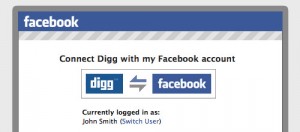Using Facebook Connect and Google OpenID on eParticipation websites
1. April 2009 – 10:50 by Bengt FeilIt is commonly accepted that the barrier to entry for participants in eParticipation action should be as low as possible. In this article I would like to take a look on a certain type of barrier, namely the registration processes on eParticipation websites, and how to make it easier for potential participants to pass it.

Most eParticipation websites rely on some sort of registration process for participants for several reasons: Once a user is registered he or she can for example be contacted, is able to build up a personality in the discussion and blocked after violating the terms and conditions of the site. This process should not be mistaken with tracking of users or a clear knowledge about their real world identity as registration on participation websites in most cases still leaves it open to the participants whether they want to participate using their real name or a screen name.

Classic websites registration processes are commonly composed of several steps:
1.) Selection of username and password
2.) Provision of email address (often verified by sending a registration link to the email address which has to be clicked by the user)
3.) Agreement to terms and conditions of the website
4.) A set of questions related to socio-demographic etc.
This process can take up some time and may lead to people either not even start or exiting the process along the way. Two things are especially problematic here: The user has to remember his or her password and the email verification forces the user to jump around between websites (the process can also stir problems with spam filters). The following approach cuts out step one and two of the typical registration process and also solves the problem of email verification and passwords by allowing users to login to the website using their existing accounts on either Google (provided with any Google-Mail account etc.) or Facebook. The first PEP-NET online discourse made use of this approach, which is now part of the DEMOS eParticipation framework, any a significant number of the participants made use of it.
To achieve this goal two technologies have to be implemented on the participation website: Google OpenID and Facebook Connect. These two technologies can each achieve a series of difference goals of which the user verification on third party websites is one of the most basic. Of course each of the two could be used individually but combing them makes sure that more visitors can use these feature. Facebook has 175 million active users and Google Mail has at least 100 million users. A third way of registration using the “classic” approach should be provided to make sure not to exclude potential participants.
Once these technologies are implemented new users arriving on the participation website can register on the site with one click of the mouse. There is no need for a password as the user verification is done by verifying that the user is already logged in to either there Google or Facebook Account. On repeated visits users will not have to login at all as the participation website notices their identity as long as they are already logged in to their Google or Facebook Account. With these steps done the third and possible fourth step of registration is a much smaller burden to the users than in a classic registration process.
The technical implementation of these two technologies may vary in difficulty depending on the frameworks etc. used but both Google and Facebook provide good technical documentation to help you get started.
If you have any questions related to these concepts and ideas please let me know!
Tags: barrier to entry, Facebook Connect, Google Login, Single-Sign-On


